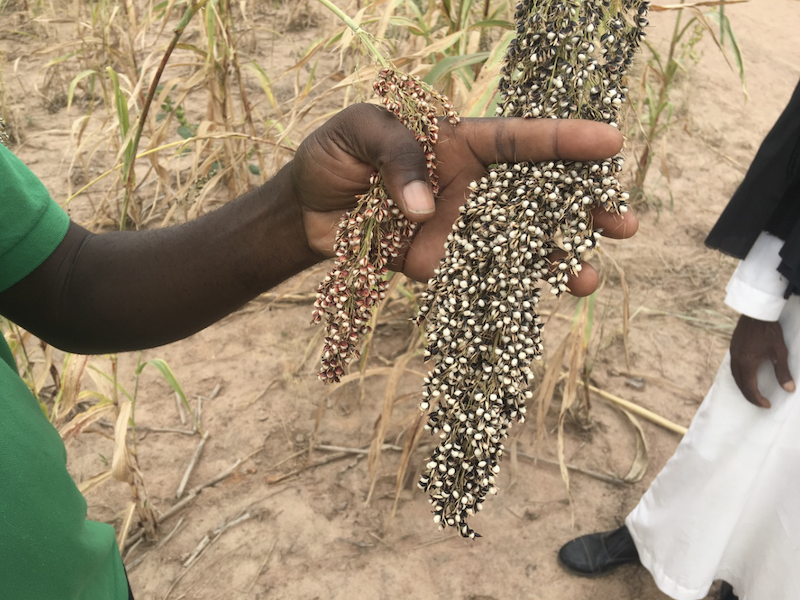Evidence Found Supporting Stay-Green Alleles Involvement in Drought Adaptation in Sorghum
Sorghum [Sorghum bicolor (L.) Moench] is a drought resistant crop of great importance as a staple cereal in developing countries in the semi-arid tropics. Periodic and more continuous drought conditions can severely limit plant productivity. The physiological and genetic basis of sorghum’s drought resistance remains poorly understood. Gaining a better understanding of this would open up opportunities for breeders to use selection to increase drought adaptability and production under these adverse conditions and would be of great interest, not only to breeders, but to sorghum geneticists as well.
A multi-institutional team, led by scientists from Kansas State University and Institut Sénégalais de Recherches Agricoles studied 590 sorghum accessions of the West African sorghum association panel (WASAP) grown in 10 different environments and conducted genome-wide association studies (GWAS) using the previous genotyping-by-sequencing (GBS) single-nucleotide polymorphism (SNP) dataset. Sorghum plants were exposed to managed water stress in four possible conditions over the course of 4 years: pre-flowering water stress (WS1), post-flowering water stress (WS2), well-watered (WW), and rainfed (RF). Days to 50% flowering, aboveground dry biomass, plant height, and plant grain yield components (including grain weight), panicle weight and grain number per plant, and 1000-grain weight were measured. Overall, across the tested environments, plant grain yield and biomass heritability was 33-92%. In the WS1 and WS2 conditions there was a significant correlation between the grain weight per plant and the stress tolerance index.
Based on the GWAS studies, it was concluded that SbZfl1 and SbCN12, orthologs of maize (Zea mays L.) flowering genes, are strong candidates for the regulation of flowering time variation under water stress. These genes were not previously pinpointed as sources of genetic variation in U.S. germplasm. Flowering time is a potential adaptive characteristic, with early flowering time allowing plants under water stress to produce flowers and seeds earlier, thereby escaping the drought. There was a lack of overlap between the pre- and post flowering drought tolerance, which indicates a potential trade-off between the two mechanisms. The fact that both flowering conditions have a moderate positive correlation with grain yield suggests that either mechanism confers drought tolerance.
Associations between the stress tolerance index and drought effects were found through GWAS; these included 16 putative pleiotropic associations. Thirty of the associations colocalized with Stg1, Stg2, Stg3, and Stg4 loci and had large effects. These stay-green (Stg) loci (Stg1–Stg4) have been linked to post-flowering drought tolerance. The Stg alleles were first found in Ethiopian sorghum lines (BTx642). The study provides preliminary support for the hypothesis that Stg alleles are involved in drought adaptation not just in Ethiopia, but across Africa as well. In addition, the study finds evidence supporting natural genetic variation for drought in West African sorghum.
“Jacques study was an important contribution because it connects a drought tolerance mechanism that was well-characterized in biparental families to broader questions on genomic basis of drought adaptation in diverse global germplasm.” – Morris
SorghumBase examples
SbZfl1 = Sobic.006G201600 and SbCN12 = Sobic.003G295300 genes are orthologs of maize (Zea mays L.) flowering genes were found to be involved in flowering time variation under water stress in sorghum.
A.

B.

Reference
Faye JM, Akata EA, Sine B, Diatta C, Cisse N, Fonceka D, Morris GP. Quantitative and population genomics suggest a broad role of stay-green loci in the drought adaptation of sorghum. Plant Genome. 2022 Mar;15(1):e20176. PMID: 34817118. DOI: 10.1002/tpg2.20176. Read more
Related Project Websites:
Morris lab: https://www.morrislab.org/home


